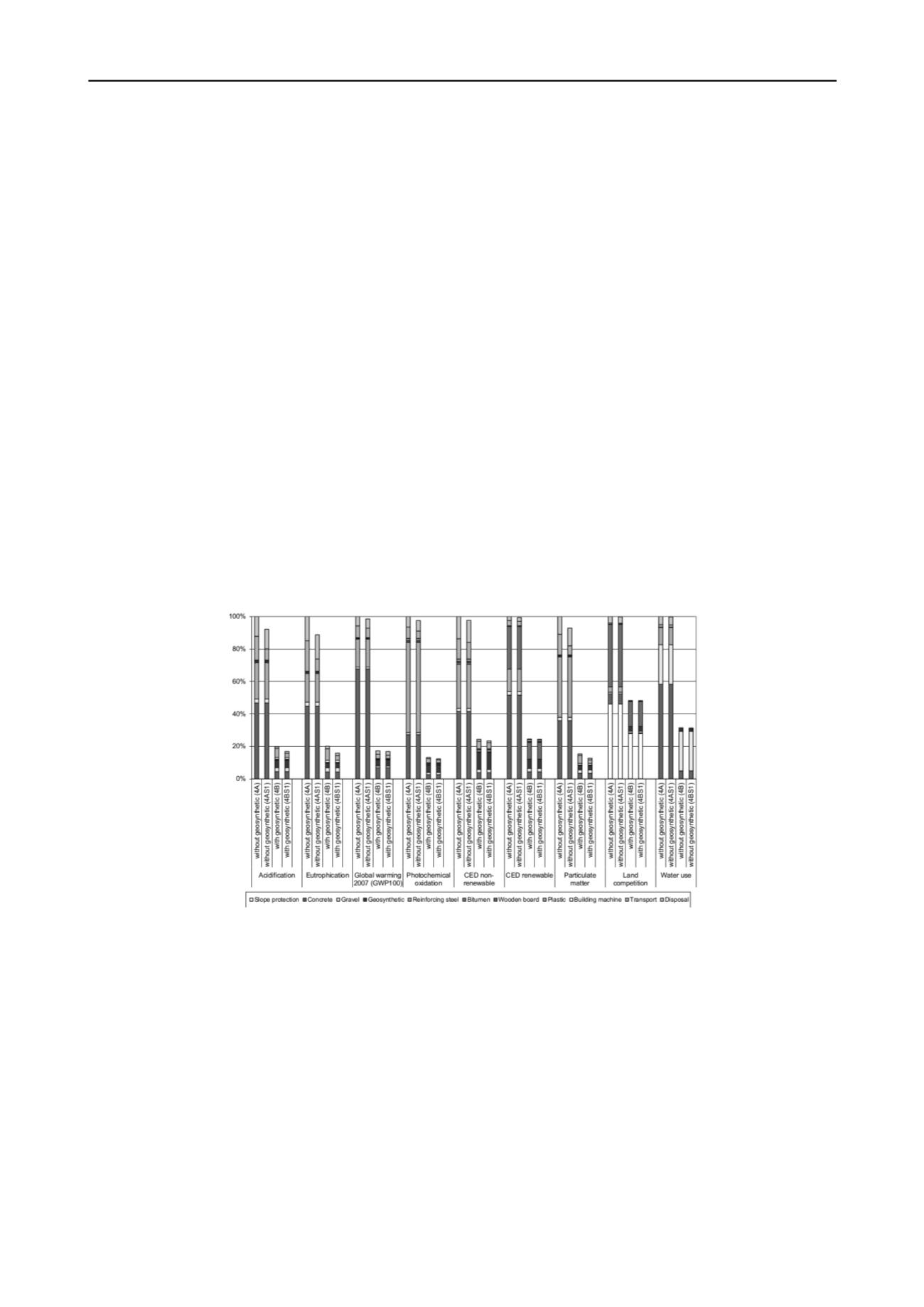
1981
Technical Committee 207 /
Comité technique 207
Proceedings of the 18
th
International Conference on Soil Mechanics and Geotechnical Engineering, Paris 2013
Concrete, the geosynthetic and transportation mostly cause
the highest burdens of the life cycle of the GRRW (4B). The
share of the geogrid to the overall impacts is relatively high
because on one hand several layers, and thus a considerable
amount of geogrid, are required. On the other hand most
materials used in the construction of the slope retention are
available on-site and thus do not cause substantial
environmental impacts (compare Tab. 1). The disposal gains
importance in the categories eutrophication and global
warming. The global warming impacts of disposal are caused
by burning geogrids in waste incineration plants, which leads
to fossil CO
2
emissions. Gravel dominates the water use
indicator and the direct land use of the slope retention wall
during its use is dominating land competition.
of GRRW (4B). The cumulative greenhouse gas emissions
amount to 1.3 t CO
2
-eq in case of the CRRW (4A) and 0.2 t
CO
2
-eq in case of the GRRW (4B). Correspondingly, the
cumulative greenhouse gas emissions of 300 m CRRW (4A)
are 400 t and 70 t in case of GRRW (4B).
The most relevant aspects concerning the environmental
impacts of the life cycle of the CRRW (4A) are concrete,
reinforcing steel, transportation and disposal. This order of
relevance changes depending on the impact category
indicators. The high share of concrete in the global warming
indicator can be explained by the production process of
clinker. During its calcination process geogenic CO
2
emissions arise. Reinforcing steel consists of 63 % primary
steel and 37 % recycled steel. Most environmental impacts of
the reinforcing steel arise from the fuel consumption and the
emissions during the sinter and pig iron production in the
supply chain of the primary steel. Disposal includes the
disposal as well as transports from the construction site to the
disposal site in case the material is not recycled. Impacts of
disposal are dominated by the high amount of concrete which
is landfilled. While direct emissions of landfilling concrete
are negligible, the construction of the landfill and the
transport of concrete to the landfill site are important. The
land competition indicator is strongly influenced by the direct
land use of the slope retention as well as by the wooden board
used in the formworks. Gravel is responsible for a con-
siderable share of the total amount of water used because
substantial amounts of water are needed in gravel production.
The main driving forces for the difference between CRRW
(4A) and GRRW (4B) are the higher amount of concrete used
in CRRW (4A) as well as the use of reinforcing steel, which
additionally leads to higher transport expenditures. With
regard to CED renewable and land competition the wooden
board additionally increases the difference in total impacts
because wood is a renewable resource with a high direct land
occupation. Direct land competition is lower for the GRRW
(4B) because the sprayed concrete lining is thinner than the
CRRW (4A) and the embankment and backfilling area is not
considered as occupied land.
The share of the geosynthetic material on the overall
environmental impacts is between 3 % and 44 % (water use
and CED non-renewable, respectively).
Figure 2. Sensitivity analysis: Environmental impacts of the life cycle of 1 m conventional (4A) and geosynthetic retaining wall (4B). 4AS1 and 4BS1
refer to the sensitivity analysis with a Euro5 lorry transportation. For each indicator, the case with highest environmental impacts is scaled to 100°%.
4.1
Sensitivity analysis
4.2
Contribution Analysis Geosynthetic Production
In a sensitivity analysis, it is analysed how the results of the
slope retention change, when a Euro5 lorry (>32 t) is used for
the transportation of the materials to the construction site
instead of an average European lorry (>16 t).
In this section the environmental impacts of 1 kg geogrid are
evaluated. The life cycle includes the provision and use of
raw materials, working materials, energy carriers, infrastruc-
ture and disposal processes. The category geosynthetic in Fig.
3 comprises the direct burdens of the geosynthetic production.
This includes land occupied to produce the geosynthetic as
well as process emissions (e.g. NMVOC, particulate and
COD emissions) from the production process but not
emissions from electricity and fuel combustion which are
displayed separately. The environmental impacts of the
geogrid are shown in Fig. 3. The cumulative greenhouse gas
emissions amount to 3.4 kg CO
2
-eq per kg.
Fig. 2 reveals that if a Euro5 lorry with lower exhaust
emissions is used for the transportation, the environmental
impacts of the GRRW (4BS1) are reduced between 0.1 % and
22.8 % (land competition and eutrophication respectively),
whereas the environmental impacts of the CRRW (4AS1) are
decreased between 0.2 % and 13.2 % (land competition and
eutrophication respectively). The use of a Euro5 lorry leads
among others to lower NO
X
emissions, which influences
eutrophication. Land competition is obviously not influenced
much by using another type of lorry.
Environmental impacts are mostly dominated by the raw
material provision and electricity consumption. Raw material


